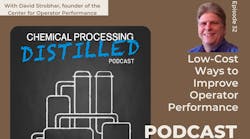In this episode of Chemical Processing's Distilled Podcast, Traci Purdum, the editor-in-chief of Chemical Processing, interviews Dave Strobhar, the founder of Beville Engineering and the Center for Operator Performance. They discuss low-cost ways to improve operator decision-making in the chemical processing industry.
Dave Strobhar emphasizes that operator decision-making is crucial for safe and efficient plant operations. He mentions that traditional decision-making models, such as cost-benefit analysis, don't apply to high-stress situations. Instead, operators rely on past experiences, using pattern recognition to make decisions quickly.
To improve operator decision-making, Dave suggests using decision-making exercises. These exercises provide operators with various symptoms and time constraints to practice decision-making under stress. He also discusses the use of simulators as effective tools for training operators, provided they focus on decision-making skills within the simulations.
Additionally, Dave emphasizes the importance of learning from past mistakes and using real-life plant events as scenarios for decision-making exercises, noting that this can help identify areas where operators need additional training.
Finally, Dave explains that operators should be trained to anticipate unexpected situations and recognize when their initial assumptions are incorrect. This ability to reevaluate and adapt their decision-making process is crucial for handling unfamiliar or unprecedented events effectively.
Transcript:
Welcome to the Operator Training edition of Chemical Processing's Distilled Podcast. This pod-cast and its transcript can be found at chemicalprocessing.com. I'm Traci Purdum, editor-in-chief of Chemical Processing, and joining me is Dave Strobhar, founder and principal human factors engineer for Beville Engineering. Dave is also the founder of the Center for Operator Performance. Welcome, Dave. I know you've been all out and about doing various things these last few weeks. Can you catch us up on what you've been up to?
Dave: Yeah, thanks, Traci. I appreciate being here again. I attended the Emerson Exchange last week and saw some of the new products that are coming out on the market and have been visiting some refineries up to our friends up north in Great White North, and that's always an interesting experience.
Traci: You say Great White North, is that Canada, or are you talking Cleveland?
Dave: Canada, in this case, yes.
Traci: All right. Well, today we're going to be talking about low-cost ways to improve operator decision-making. And I know you have many thoughts on this. I'm anxious to learn more. So, let's get right into it. And I guess the first question is, what factors typically influence operator decision-making?
Dave: Well, it's interesting in that there used to be decision-making... The classic approach was that you defined the problem and you created options and then you looked at the cost-benefit of those options and chose the best one. And indeed, that might be a way you would make a decision on how to buy a house. But some of the research by Dr. Gary Klein on how people make decisions in a natural environment says that's not true, that's not how people make deci-sions under stress. What they do is they reason by analogy, they think, have I seen a situation like this before or experienced a situation like this before? And did it work or did it not work? And adjust their actions accordingly, they don't consider different options. It's a pattern match, if you will, between what is the problem I'm seeing now and have I seen that problem in some form before that. So, the most important thing is that they have a good library of these other instances, these other times in which they can make those comparisons because if they don't, then they're automatically handicapped in their ability to come to the correct decision.
Traci: Having this library and being able to draw on that, are there any specific decision-making exercises that can be used to train the operators to be better able to tap that library?
Dave: Oh, absolutely. And that's where I think the industry is solely behind what some other people are doing in the military and aerospace to improve that library of patterns that they can rely on. So, the Center for Operator Performance, we funded several different studies and have developed a set of decision-making exercises where the idea is you will take a group, typically, it's not a one-on-one, but multiple individuals. And there's another process called ShadowBox, which is essentially the same thing, but it has canned responses from some other individuals. Take somebody through a typical problem set. At first, when I was first exposed to this, I thought, oh, well, this sounds like a what-if drill, and I've always found what-if drills to be lack-ing in their ability to teach. And, the big difference is these decision-making exercises do not give you what happened, because I don't just say, well, your reflux pump tripped, what's going to happen?
They give you symptoms, and that's the key thing. They're symptom-based. And so these decision-making exercises will give you symptoms, they ask you in various stages, so you're go-ing to go through multiple stages in terms of your decision-making process to try to come to, well, what is happening here? So the initial question will give you a variety of symptoms that are both relevant and irrelevant to the situation. So one of the ones we use on a rather generic basis is, well, your symptom is you've just gone through a car wash, automatic car wash, and you come out and you drive the car, it's a very windy day, so you didn't even need to dry it, the wind did it for you. As you start to drive on a straightaway, you notice the car is pulling to the right — what do you think is the cause?
And you give them a time limit because that's one of the key things in a natural setting. There's time pressure. Tell me what you think is causing this right now. You have 15 seconds or you have 30 seconds. So you're putting some stress into that decision-making process, which really helps. It's been said that bringing the operations manager in and having them watch this exercise really adds stress to the process. But now, so you have a couple different things. Now, the real problem may be, well, you have... Your right front tire is low in air, but because you've thrown in these other issues, you have to consider, well, was it something that when I went to the carwash, did it damage the frame or did it do something? And the wind, well, is it just pull-ing to the right because the wind is blowing that way?
So you're throwing in these extraneous variables and then you will bring them down and provide additional information as it goes. So it's a multi-step and you're taking them through this decision-making process. And at each point, you can do some different things. Like I said, on the first step, you might say, well, what do you think is wrong? And maybe at another step, you would say, well, what additional information would you like to have, geared toward trying to find out where would they go for information or what information do they want or need? These can be done in a small group setting, paper, pencil, there's nothing elaborate that needs to be done. As I said, you can automate them in this program called ShadowBox. It's not as much of a group effort. It can be done without a facilitator so they can go faster.
But because they're paper and pencil, the only real cost that you're having with these is the time it takes to develop them and the cost of the facilitator to take the operators through these exercises. They can go pretty fast. I mean, they're under an hour. So rather than pulling an operator in on an off day and paying overtime, these can be done in an hour before or after their normal shift. So they're very easy to fit into the training model. And it's all geared toward helping them see things differently to increase that library of events and, therefore, be able to make decisions better. So they're practicing these decisions and they're modifying their mental library as they go forward.
Traci: So it's a completely holistic approach, almost like a doctor trying to figure out what's go-ing on, although you have that time pressure added in to make sure that they don't take days to come to a resolution, they have to come in at this. And you mentioned the ShadowBox program, is that something they can purchase?
Dave: It is something they can purchase. There's a company called ShadowBox LLC. They have been working with the Center for Operator Performance. They're going to be presenting at our fall meeting next week and actually training people how to develop these ShadowBox exercises. So it is something that they can purchase how to do it, or have the company help them. And Gary Klein, who I mentioned earlier, has been leading this new way of decision-making, he is part of that company to develop this training process.
Traci: It's very cool. I'm curious though, was there a resolution, what was causing the car to pull right?
Dave: Yeah, low air in the right front tire.
Traci: Oh, it was that?
Dave: Yeah, yeah.
Traci: So the car wash and the air drying were just a ruse?
Dave: Yeah. Red herrings. I was with test subject when they were developing these and I had come up with the wrong solution and they asked me, they said, "Well, we told you about these pressure spikes, what did you think about that?" And I said I didn't know what to do with that information. So I just ignored it because it didn't fit my scenario of what I thought was happen-ing, which was what was really happening. And that's what should have triggered me to think of... go for something else. Don't just throw out data you don't like because it doesn't fit your notion of what's going on, but use that to recenter yourself and say, well, wait a minute, what would cause those pressure spikes that you can't understand why those are occurring.
Traci: Interesting. Well, it's a great low-cost way to improve operator decision-making. Are there other ways, anything else in your bag, tricks there?
Dave: Well, not necessarily low cost, if you're starting from scratch, but a lot of people have gone to using simulators because one of the key issues in both these decision-making exercises and in simulators is that decision-making is a skill, and it's a skill like any other skill. How do you get skilled at anything? Well, you practice it. Somebody teaches you how to do it. Here's some instruction on what we're going to have you do, and I'm going to demonstrate it. Now, you do it, and then I'll tell you how well you did. So those are the four steps: your instruction, demonstration, practice, and feedback. Well, if I really want to get good, I have to practice it a lot. And so the notion with simulators, a lot of companies have bought simulators and have done wonderful things with them. Other companies have bought simulators and they're gather-ing dust and being cannibalized for spare parts.
But it has to do with, are you using it to train the right skills? So the development of the decision-making skill as it were, you need to be actually focusing on that. It's not just a matter of I'm going to randomly go into a simulator and manipulate variables and so on, but have I structured the simulation training to look at how they're going to make a decision in this? If I just ask them, well, I want you to change the feed rate from 75% to 100%, well, they can go through that and it's proceduralized. But if I want them to practice their decision-making skills, then I have to throw in decision points that they need to understand, or take advantage of. And Nova Chemicals has done a very good job in their training program with their simulators, where they will take operators through a particular upset, and rather than just take them all the way through the upset, they will typically fail a valve so that what it's showing on the simulator is not what it's really doing.
So on the simulator, it may show that it's at 50%, but the reality is it's closed in the field. And so part of it is then trying to understand why is my response or the plant not respond-ing as expected? And their job is then to figure out which valve has failed and bring in some other questions, what else do you need to know or what else do you want to see? So if you use simulator, if you have a simulator and you want to get the most out of it, then you really need to look at how am I incorporating decisions into the simulator exercises. So it's not just, well, take me through a normal startup or take me through a trip of this particular piece of equip-ment, but provide opportunities for making decisions and in particular, why is this not respond-ing the way I think it's responding. So simulators themselves are a little pricey, but if you al-ready have one or thinking of getting one, a low cost way to make it more effective is to incor-porate decision-making as a distinct aspect of the training program.
Traci: What about learning from past mistakes?
Dave: Yes, absolutely necessary. And so often not done. I was actually investigating a power failure that had occurred at this plant and we were looking at how they responded and I was talking to an operator on a unit propane de-asphalting unit. So they're dealing with asphalt, very heavy, very thick. And the operator said, "Well, as I was going through my response, I thought I had time to... I was going to secure these particular propane pumps later in the event, but it turns out I didn't have enough time, and by the time I got to them, they were full of as-phalt. And that set us down for a while." And I relayed that story to one of the shift foreman and he chuckled and he said, "Oh, that exact same thing happened to me." And so here, you had a case where they didn't learn from past events.
So capturing those events in some form, in some sort of library to say, what has hap-pened, what worked, what didn't work? And then those often become the scenario for these decision-making exercises. So you want to use those events, you want to capture that real-life aspect of what is going on, but then make sure that as people are coming in, they're basically exposed to that same event. What makes a good operator? Well, they've experienced a lot. And nowadays, with increased reliability and advanced process control, thankfully, operators aren't seeing as much. And so you need to distill the experience of the entire facility and per-haps, your entire organization and use that to create these exercises where you are going to allow the trainee to experience the event in a rather series of events in a short period of time, you're going to distill that experience from past upsets. And now let's make sure that everyone is aware of what the key decisions were, and in particular, if they were led astray by something, why were they led astray?
Traci: Thinking of all of this and knowing that a lot goes into training and making sure that operators have a sufficient recall of what they think can happen and what should happen, is there a way to monitor and evaluate the quality of their decision-making?
Dave: Absolutely. And it actually came out, it was one of the early outputs of these decision-making exercises. There was a plant, they were going through these exercises and as I said, you just do it as a group. And the idea is so I can get the mental model from different members of the group, what were you thinking and why were you thinking that? And it allows them to adapt to what was happening. And so they had a series, or they had a session with some... Some senior operators were mixed in with this and they were going through this particular event, and the company's absolutely shocked that the operator that they thought was the weakest and would really struggle and really need help just aced it, just flew through it. And the operator that they thought was really, really good clearly did not understand how this particular system functioned.
And in retrospect, what they realized is the operator they thought was going to struggle is just not very verbal. He just doesn't talk a lot. And so they had equated his lack of talking with lack of knowledge. And of course, the operator that did struggle was just the opposite. He talked a lot and he talked a good game, but he didn't really understand the underlying operation. And so it quickly identified from this exercise where people have gaps and need help. Again, because real events don't happen often enough that you can use them to grade how a person does, these decision-making exercises allow you to expose everybody, as you say, use past events that have happened at your plant, and they will get to, do you understand the underlying issues that you're dealing with?
Why do you want to see that variable? Or what impact would this have in terms of creating these symptoms that I'm seeing? And so that can come out and has been very useful for some companies to identify, oh, wait a minute, this person, they know the pieces of equipment and all of that, but they don't understand how they function as a whole. And that's what these decision-making exercises can allow you to get some insight into, wow, this person really doesn't understand this to the degree that we would like them to, and then of course, provide some additional training to fill that gap.
Traci: You can train, and you can give them all the resources that they need and all the backstories and whatnot, but what happens when they come up to something un-familiar or unprecedented? Is there a way to train for that or better prepare folks?
Dave: Well, yeah. So again, this comes from Dr. Klein, but when you look at people in these high-stress situations and how they make decisions, one of the key things that distinguishes a novice from an expert, in part because they have this library is that experts will anticipate what they would expect to see. So they will do the diagnosis, and I think this is it, and I'm going to... and they develop a course of action. And one of the key things is, is it behaving as expected? And if it's not behaving as expected, you need to go back and reassess what's going on. And so as people go through, one of the things they need to be aware of is that this is not going right. It should be doing something different than it is now. My course of action is incorrect. I need to go back to the start.
And that's one of the key things, is that ability, the psychological was to decenter and look at this from an outsider's perspective and say, no, this should not be happening this way. I worked at Three Mile Island after the accident, and if you look during the accident, the opera-tors saw this decline in pressure and increase in temperature and they took some actions, helped with the pressure but the temperature kept increasing. And so their assessment that the cause of the event was a loss of coolant, that's when they should have said, wait a minute, we're putting more coolant into the system and the temperature's going up. This doesn't make sense. And that's where that notion, if you're saying to yourself, this doesn't make sense, well, the reason that probably doesn't make sense is your assessment of what's happening is wrong and you need to go back and start from square one and say, what else could this be?
Would that situation respond in what I'm seeing? So they have to take in what they're seeing and be able to say, no, this is not the way I thought it should go. I'm probably wrong in my assessment of what's happening. What else? What were my other options? So just as in the example of the tire and so on, you might do some different things, find out that... You say, wow, it's a really windy day and it's pushing my car to the right. One of your expectations would be, if I make a turn onto a different street and I'm now at 90 degrees from where I was, well, the problem should correct itself.
And if it doesn't correct itself, then, well, I think you probably have the wrong decision. And so you need to say, well, it's probably not the wind because now I'm going straight into the wind. And it's the person that would get home and say, wow, it's really windy out there, it's pushing the car to the right. And it's like, yeah, well, the car was going to the right regardless of the wind direction. So you need to look at what is it different, what else could it be that caused that to happen?
Traci: And if you were in the '70s, that could have been just the Nova you were driving. Remember those?
Dave: I had one.
Traci: Dave, is there anything you want to add on this topic that we didn't touch on?
Dave: I just say, this concept of practice is key and we tend to really focus on instruction and demonstration. But the inability to practice is something, and the industry's getting much better at that one. When I started, when somebody would quote, "practice and upset", they would just review the procedure in the control room. Now, after having walked through some of those procedures with people, and I would say this person can't find that valve, a lot of plants have shifted to red tag drills. So we're going to go out and you're going to put a tag on the valve that you're supposed to turn, or the pump you're supposed to start to make sure you know where it is. So if it's 3:00 AM and freezing rain in Cleveland, you can still perform. The ability to practice those activities is key. And I think that's where, as an industry, we're doing more, or we're doing more than we used to, but we still have more to go in providing that opportunity to the operators.



